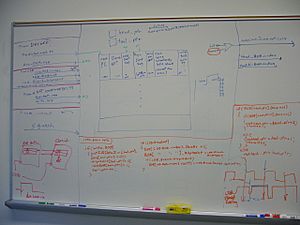Whiteboard facts for kids
A whiteboard, also known as a markerboard, is a smooth, usually white, surface that you can write on using special markers. These markers are easy to erase, making whiteboards great for quick notes, drawings, or teaching. Whiteboards often have a shiny surface.
Before whiteboards became common, people mostly used blackboards, which required chalk for writing. Today, there are even more advanced options like interactive whiteboards. These are electronic whiteboards connected to a computer, allowing you to control them with a special pen or even your finger. Interactive whiteboards became very popular in schools, especially in England during the 2000s.
Contents
What is a Whiteboard?
A whiteboard is a modern writing surface that lets you write and draw using special dry-erase markers. Unlike chalkboards, which use chalk that can create dust, whiteboards use markers that are clean and easy to wipe away. This makes them a popular choice in schools, offices, and homes.
How Do Whiteboards Work?
Whiteboards have a smooth, non-porous surface. This means the ink from the dry-erase markers sits on top of the surface instead of soaking into it. Because the ink doesn't absorb, it's easy to wipe off with a cloth or a special eraser. The surface is usually white to make the colorful marker ink stand out clearly.
Types of Whiteboards
There are several kinds of whiteboards, each with different features:
- Melamine Whiteboards: These are often the most affordable. They have a melamine resin surface over a particle board. They work well for light use but can stain over time if not cleaned regularly.
- Lacquered Steel Whiteboards: These boards have a painted steel surface. They are more durable than melamine and are often magnetic, which means you can stick notes or pictures on them with magnets.
- Porcelain or Ceramic Steel Whiteboards: These are very strong and durable. They have a ceramic surface baked onto steel, making them highly resistant to scratches, dents, and staining. They are also magnetic and are great for heavy use, like in busy classrooms.
- Glass Whiteboards: These are made from tempered glass. They look very modern and are extremely durable, easy to clean, and won't stain. They are often magnetic too, but they need special strong magnets.
- Interactive Whiteboards: As mentioned, these are electronic boards connected to a computer. They allow users to control computer programs, write, draw, and save their work digitally. They are often used for presentations and teaching.
History of Whiteboards
The idea of the whiteboard came about in the mid-20th century. Here's a quick look at their development:
- Early Ideas: Some sources say the first whiteboard was invented by Martin Heit, a photographer, in the 1950s. He noticed that ink from felt-tip pens could be easily wiped off film negatives.
- First Public Appearance: Whiteboards started appearing in the market in the early 1960s. They were initially used in offices and businesses.
- Becoming Popular: Whiteboards really took off in the 1990s. This was partly because people became more aware of dust allergies caused by chalkboards. Also, the development of better dry-erase markers made whiteboards more practical and appealing.
- Digital Age: The 2000s saw the rise of interactive whiteboards, bringing technology directly into the classroom and meeting rooms.
How to Use and Care for a Whiteboard
To keep your whiteboard in good condition and make it last longer, follow these simple tips:
- Use the Right Markers: Always use dry-erase markers specifically designed for whiteboards. Permanent markers will stain the board and are very hard to remove.
- Clean Regularly: For daily cleaning, a dry cloth or a special whiteboard eraser works well. For a deeper clean, especially if you see ghosting (faint marks left behind), use a whiteboard cleaning spray or a damp cloth with a little soap and water.
- Avoid Scratches: Be careful not to use sharp objects on the board, as scratches can make it harder to erase marks cleanly.
- Store Markers Properly: Keep your markers capped when not in use to prevent them from drying out.
Whiteboards are a fantastic tool for learning, brainstorming, and sharing ideas. They are clean, reusable, and easy to use, making them a staple in many environments today.
Related pages
Images for kids
See also
 In Spanish: Pizarrón blanco para niños
In Spanish: Pizarrón blanco para niños






